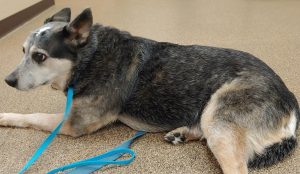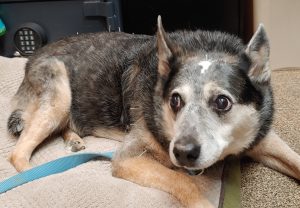Written by a CuraCore Veterinary Medical Acupuncture course graduate. Signed release obtained from client/author. 4S2019026
ABSTACT: Acupuncture and cold laser treatment of osteoarthritis in the thoracolumbar, lumbar, and lumbosacral vertebral regions of a geriatric cattle dog with compensatory strain patterns affecting cervical musculature. Acupuncture and cold laser together provided synergistic improvement in patient mobility and quality of life.
HISTORY: “Dylan” a 14yo MC Australian Cattle Dog living in Phoenix, Arizona presented for painful and sore in back end for a few years. Owner feels he is sore in front end evidenced by intermittent right front (RF) lameness after jumping off bed or quick burst movements. Lameness is usually walked off within a few minutes. Patient has seasonal fall allergies which is flared right now. Patient is very pruritic at tail base. Has been managed with Cytopoint. Activity consists of short walks to mailbox, roughly ½ mile. He walks better now that it has cooled off. No other medical history. No history of trauma. Recently moved from Ohio in January 2019. No daily medications or supplements given. Diet consists of Fresh pet or Dr Harvey’s base mix with homemade cooked beef.
PHYSICAL EXAM: Vitals within normal limits. Body Condition Score (BCS) 3.5/5. Lenticular sclerosis in both eyes. Decreased range of motion (ROM) in coxofemoral joints (CFJ) bilaterally on both flexion and extension, reactivity right worse than left. Patient resistant to full limb flexion on RF limb. Patient was intermittently grade 1/5 lame on right front limb. No neurologic or other abnormalities appreciated.
MYOFASCIAL EXAM: Patient was very tense in shoulder and caudal neck musculature right worse than left, trigger point (TP) found just cranial to Gall Bladder (GB) 21 on right side, reaction to palpation from thoracic (T) vertebra 10 to Lumbar (L) 1 with skin twitching and aversion to palpation. TP found in epaxial musculature along T9-T12. Sensitivity along lumbosacral (LS) region and sacroiliac joints (SIJ) on palpation.
NEUROLOGIC EXAM: No deficits appreciated.
DIAGNOSTICS: Complete blood count and Chemistry in April 2019 were within normal limits (WNL), along with Total T4, and urinalysis. Unsedated radiographs revealed mild osteophytes and spondylosis between C3-C4, C4-C5, C6-C7, moderate-severe spondylosis T5-T6, T6-T7, T9-T10, T11-T12, T12-T13, T13-L1, L1-L2, L2-L3, and LS, slighlty irregular femoral heads bilateral but symmetric, acetabular coverage appears normal bilaterally, necks appear thickened bilaterally, osteophyte on cranial aspect of left acetabular rim, left elbow and shoulder appear WNL.
PROBLEM LIST:
1) Chronic Pelvic Limb Weakness
2) Intermittent Lameness RF
3) Known Allergies
DIFFERENTIAL DIAGNOSES
1) Chronic Pelvic Limb Weakness: Vascular – thromboembolism. Infectious/Inflammatory – coccidioidomycosis, other fungal, osteomyelitis. Neoplastic – osteosarcoma, chondrosarcoma, nerve sheath tumor. Degenerative – degenerative joint disease/osteoarthritis, intervertebral disc disease, hip dysplasia, muscle atrophy secondary to osteoarthritis. Iatrogenic/Intoxication – none. Congenital – none. Autoimmune – IMPA. Traumatic. Endocrine/Metabolic – hypocalcemia, hypoglycemia, hypokalemia. Myofascia – trigger points, strain patterns.
2) Intermittent Lameness RF: Vascular – none. Infectious/Inflammatory – biceps tendonitis, other soft tissue injury, coccidioidomycosis, other fungal, osteomyelitis, foreign body. Neoplastic – osteosarcoma, chondrosarcoma, nerve sheath tumor. Degenerative – degenerative joint disease/osteoarthritis, intervertebral disc disease, elbow dysplasia. Iatrogenic/Intoxication – none. Congenital – none. Autoimmune – none. Traumatic. Endocrine/Metabolic – none. Myofascia – trigger points, strain patterns.
PUTATIVE DIAGNOSIS: Suspect top two problems are related. OA and degenerative changes of hips led to mild disuse atrophy of cranial pelvic limb musculature and vertebral instability creating spondylosis along cervical, TL and lumbar regions. Suspect intermittent RF lameness is due to strain of soft tissue structures due to overloading and overstraining soft tissues of RF limb.
Boney neoplasia unlikely but cannot be ruled out as no long bone pain or masses appreciated, no lytic or proliferative bony lesions on radiographs. Peripheral nerve neoplasm also not as likely as deficits appear bilateral and no obvious conscious proprioceptive or other neurologic deficits. Vascular accident unlikely as presentation was not acute. IVDD still a great differential but survey spinal radiographs did not show changes in intervertebral disc space width or calcification of discs. Hip dysplasia unlikely as patient developed signs later in life and femoral heads had adequate acetabular coverage on radiographs. Coccidioidomycosis unlikely due to patient new to endemic area, no other clinical signs, and no bony changes on radiographs, also all lameness signs present prior to relocation.
MEDICAL DECISION MAKING: Acupuncture plan revolved around decreasing wind-up and arthritic pain, addressing compensatory strain patterns, increase parasympathetic autonomic nervous system (PANS) input, and releasing myofascial trigger points to help relieve muscle compression and ischemia. Photobiomodulation was utilized to boost the acupuncture plan for Dylan to directly access the degenerative joints and muscles affected by myofascial dysfunction to reduce inflammation, reduce pain, and increase mitochondrial oxygenation for improved tissue healing and repair.
TREATMENT: All treatments utilized Millennia 0.20x13mm [36#0.5”] needles and SpectraVet 1000mW Continuous Wave Laser.
10/19/19: initial treatment

Dry Needle (DN): Governor Vessel (GV) 14, GV20, Bladder (BL) 21, BL23, BL54, BL40, GB21, Stomach (ST) 36, BaiHui
Cold Laser: 20 seconds (s) over TL junction, 10s over each SIJ, 10s over each CFJ
10/23/19: Evaluation – Dylan did well after first acupuncture session. Owners noticed he had more longevity on walks and was more willing to sit, appearing less painful. Owners feel the effects are wearing off, he is stiffer. Chewing of tail has improved on Cytopoint. Otherwise no other concerns. Physical exam unremarkable. Myofascial exam revealed sensitivity to left hip and around location of BL23 left more than right.
DN: GV14, GV20, BL21, BL22, BL23, BL54, BL40, BaiHui, ST36, GB21, Large Intestine (LI) 11
Cold Laser: 20s over TL junction, 10s over each SIJ, 10s over each CFJ

11/16/19: Evaluation – Dylan did well for roughly 10 days after last acupuncture session, was walking better, more willing to jump on/off bed. After the 10-day mark, he was stiffer and less willing to jump on/off bed.
DN: GV14, GV20, BaiHui, BL10, BL11, BL13, BL21, BL23, BL54, GB29, GB30, LI10R, ST36, Small Intestine (SI) 9
Cold Laser: 20s TL junction, 10s each SIJ, 10s over each CFJ, 10s each elbow, 30s over dorsal neck musculature

12/10/19: Evaluation – Dylan showed marked improvement after last treatment. He appeared much more comfortable in general and was willing to play and snarl at housemate some. Owner noticed effects lasted him roughly 3 weeks.
DN: GV14, GV20, BaiHui, BL10, BL11, BL21, BL23, BL54, ST36R, LI10, SI9, Triple Heater (TH) 14
Cold Laser: 20s TL junction, 10s each SIJ, 10s over each CFJ, 10s each elbow, 30s over dorsal neck musculature
OUTCOMES, INSIGHTS, DISCUSSION: Medical Acupuncture and related techniques made significant and meaningful improvements to Dylan’s quality of life. Each acupuncture session included ST36 to support his PANS, GV20 to help with anxiety, and points related to the areas of known osteoarthritis. The second treatment focused more on the hips which had a more favorable pain-relieving effect than the first treatment, evidenced by owner joy over increase stamina and strength on walks. The third treatment addressed more of his compensatory strain patterns of his neck and thoracic limb musculature. After the third treatment, the owner reported Dylan was much more energetic and willing to ‘play as a heeler does’ with invites to play and snarls with improved ability to jump on and off bed.
I believe treating his secondary strain patterns and myofascial dysfunction improved his response dramatically because the compensation is continual, cyclical, and additive. Strain patterns continue to evolve over a broader area, contributing to increased muscle shortening and associated ischemia and pain.
Recommended treatment plan for Dylan is acupuncture and laser treatment every 3-4 weeks. I may also utilize non-steroidal anti-inflammatories and pain medication as needed to complement my acupuncture and laser treatments. I learned how powerful it is to treat beyond the primary problem and address secondary disorders appropriately, especially when involving musculoskeletal and myofascial systems.
No adverse events occurred during any treatment.
RESOURCES:
1) Manyanga, T., Froese, M., Zarychanski, R. et al. Pain management with acupuncture in osteoarthritis: a systematic review and meta-analysis. BMC Complement Altern Med 14, 312 (2014) doi:10.1186/1472-6882-14-312
2) Witt, C. M., Jena, S., Brinkhaus, B., Liecker, B., Wegscheider, K. and Willich, S. N. (2006), Acupuncture in patients with osteoarthritis of the knee or hip: A randomized, controlled trial with an additional nonrandomized arm. Arthritis & Rheumatism, 54: 3485-3493. doi:10.1002/art.22154